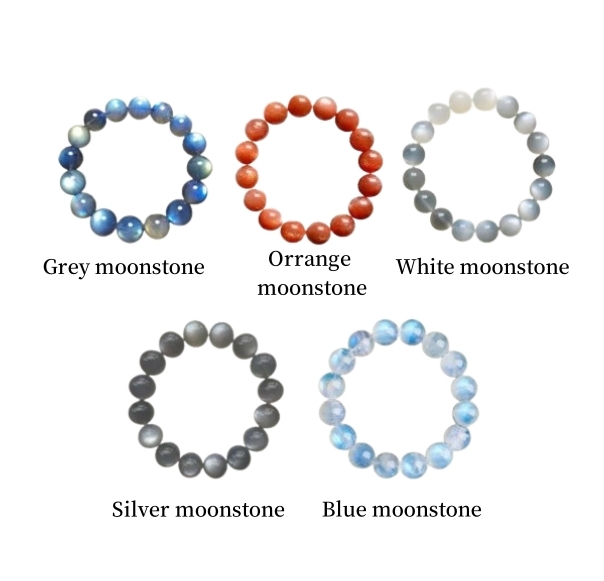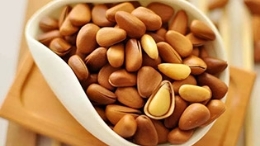💙 Moonstone, also known as moon feldspar, is a feldspar family mineral with a moonlight effect, in which orthoclase and sodium feldspar are distributed in alternating layers during formation. When light passes through these flat thin layers, it is refracted in many directions, producing the phenomenon of greenish-white luster. This blue-white lustrous moonstone was once called “ice feldspar”, a name derived from a Swiss mountain. Adualr (present-day St. Gotthard) is one of the premier sources of high-quality moonstone.
🔹Mineral: Feldspar
🔹Chemical composition: potassium-sodium silicate
🔹Hardness:6.0 to 6.5
🔹Specific gravity:2.58
🔹Refractive index: 1.518 to 1.526
🔹Birefringence: 0.05 to 0.008
🔹Color: Colorless to white, gray, green, peach, brown, etc.
🔹Origin: Sri Lanka, India, etc.
💙 True to its name, the moonstone emits a halo like moonlight, white with a light blue hue, and with its translucent texture, it really is like a miniature moon, gentle and lovely. It is often made into jewellery together with sapphires and diamonds, and its cool hue exudes a mysterious atmosphere.
💙 Because it emits a unique halo, loved by many people, once popular film “Twilight” heroine Bella often wear the ring, looks like an ordinary stone, actually moonstone.
✨Moonstone, also known as the precious gift of the Moon God to mankind, contains mysterious and fascinating power. It is also known as the “lover’s stone”, symbolising deep friendship and eternal love, and is a good gift to express true feelings. Legend has it that when the moon is full, wearing a moonstone will lead to a good marriage. As a commemorative gemstone for the 13th wedding anniversary, moonstone has witnessed countless beautiful moments of loving couples. At the same time, it is also the birthstone of June, bringing warmth and blessings to every life born in summer.
✅Moonlight effect
➡When light meets a gemstone, it undergoes multiple reflections and refractions within it, creating a unique greenish-white lustre. Some people refer to this as the moonlight effect, while in the industry we prefer to call it blue-light. This light acts as a liquid glow flowing inside the stone, causing the surface of the moonstone to radiate brilliantly. Every time the stone is moved or the viewing angle is changed, the fascinating halo of light seems to dance with it, bringing endless surprises to the viewer.
✅Moonstone Colours
➡ Moonstones are classified by colour, it is divided into colourless, yellow, orange and brown. According to the halo colour, it is divided into colourless, blue, white and coloured.

💙 The best quality moonstones are those with a blue halo, followed by those with a bright white halo, and have a fine texture, high transparency and few fissures. However, since moonstone is only moderately hard and is prone to breakage when struck by an external force, care must be taken in storing it.
🟤Grey Moonlight: High-grade ice translucent grey background, the crystal is clean and translucent body of the natural light refracted blue light.
🟠Orange Moonlight: Warm orange tone with golden sand dots, showing unique temperament and glamour on the body.
⚪️White Moonlight: the stone of the goddess, loved by the public, almond paste like milky white, very gentle.
⚫️Silver Moonlight: cool wearing silver grey, with silver luster, very textured, suitable for cool sisters to wear.
🔵Blue moonlight: unparalleled romantic only look at the blue moonlight, as if by the soft moonlight enveloped, emitting a light blue flash.

✅Classification of moonstones
➡According to the physical properties and appearance characteristics of moonstone. Moonstone is divided into: rainbow moonstone, vitreous moonstone, cream moonstone, moonstone cat’s eye and so on.
🔵The rarest moonstone is the vitreous blue moonstone. But it is worth noting that the blue moonstone itself is not blue, it is itself colorless, but its halo is blue. In other words, it is a blue “moonlight”.
🌈Rainbow moonstone is a moonstone with colored halo.
🟡Moonstone cat’s eye, which is a moonstone with a cat’s eye effect.
✅Origin of Moonstone
➡An important source of moonstone is Sri Lanka, located in the areas of Ambalangoda in the Southern Province,Dumbara and Kandy regions in the central provinces, where it is found in alluvial gravels and is of the highest value.
➡India also produces moonstones with variations in body colour, from reddish brown and white to blue and green. Other sources are Burma, Brazil, Madagascar, the United States, Australia and China. In addition, it is believed that the ancient Chinese Heshi Bi is a type of moonstone.
✅Selection of Moonstone
➡Look at the light:The highest value is blue light, which is preferable to deep blue, frontal, and large light surface. The second is coloured light, with rainbow colours and ribbons of colour being preferred. The most inferior is white light, it is only halo colour without blue light though. In addition, the best moonstone also has cat’s eye effect or starlight effect, but rarely seen, especially the starlight effect is more rare.
➡Look at the body:According to the degree of transparency, from high to low can be divided into: vitreous > high ice > ice > cream > general.
➡Look at the size:Moonstone particles are generally small, generally speaking, more than 5 carats of moonstone belongs to the large particles, has investment value, more than 10 carats is the collection level.
Follow us to learn more about jewelry knowedge!


